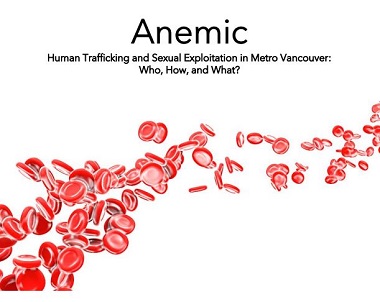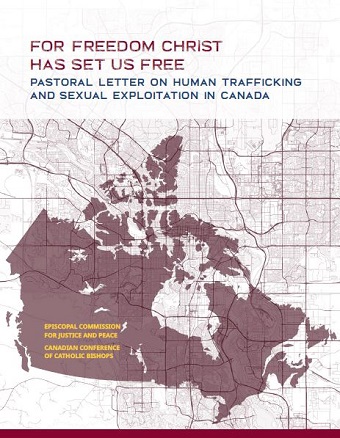
Karen Giesbrecht is the main author of ‘Anemic: Human Trafficking and Sexual Exploitation in Metro Vancouver: Who, How and What?’ Go here for the full 19-page report.
We have all been part of conversations about how much life has changed for us. We have been reminded to be grateful for the stability and connections we have, and we have been inconvenienced by canceled events, supply chain disruptions and changing restrictions on who we can gather with.
Any negative impacts are exponentially harder for those who were already vulnerable before the pandemic.
Such conversations led Union Gospel Mission’s (UGM’s) Church Relations team – which exists to support congregations addressing poverty, homelessness, addictions and food insecurity – to conduct a survey of how churches are raising awareness and advocating for individuals vulnerable to human trafficking and sexual exploitation in Metro Vancouver and the Fraser Valley.
Needs, key stakeholders and gaps have been explored, particularly considering significant changes made due to the COVID-19 pandemic. Following is an introduction; find the full report here.
In general, local churches recognize that they are best positioned to come alongside organizations that are equipped to support vulnerable individuals through awareness, funding, prayer and meeting practical needs.
‘Anemic’ response
Some interviewees reported that there are currently few churches directly addressing these issues for vulnerable individuals. One person called the response of the local churches “anemic,” which inspired the title of the report.
But overall, we found that while much more could and must be done, there is certainly evidence of significant compassionate care.
This report begins with a summary of the awareness-raising activities done by local churches and the challenges of addressing the complexity of issues related to human trafficking. This is followed by examples of both direct initiatives and indirect interactions that faith communities are undertaking to support those at risk of exploitation and trafficking.
Given that this report was completed almost two years after the COVID-19 pandemic was declared, we explored the changes that have been experienced, populations who are underserved or underrecognized as being vulnerable, and key pandemic lessons.
The report concludes with a summary of what churches and local organizations need to sustain themselves in this work, and then consider resources for further exploration.
Distractions
With a few solid exceptions, most local congregations are not talking about human trafficking and sexual exploitation as much as they were a decade ago.
In part, congregations are investing in other work that addresses the roots and brokenness associated with these challenges, and in part exploitation is difficult to talk about. We often do not have the language to describe realities, and the terms we use may have different meanings for different people.
While advocates share the same goal – freedom for those who have been exploited – there are controversially different approaches. And most intractable of all, the demand for exploitation must be addressed. If our society did not tolerate cheap labour, pornography and massage parlours, we would reduce the opportunities to take advantage of vulnerable people.
Joint efforts
Like anemia, we cannot correct human trafficking with simple, one-off interventions. It will take caring, attentive, teachable, Spirit-led individuals from various fields – law enforcement, medical care, spiritual direction, education, advocacy and more – to prevent exploitation and support the individuals who have been harmed.
Walking alongside survivors will be a long, deep, holistic journey. Much of this work must be done by those who are equipped and have the capacity to do it well; inadequate interventions can further harm vulnerable people.
And still, there are many things we can do for our neighbours in need. Start by learning about the issues that fuel demand and by doing all we can to protect the vulnerable. Advocate for strong, protective laws, with our commitment to social justice grounded in our spirituality – being shrewd as snakes and inoffensive as doves.
Resources
 This review does not cover current statistics around human trafficking and sexual exploitation in Metro Vancouver, or all the work that is currently done to directly support individuals caught in or exiting harm.
This review does not cover current statistics around human trafficking and sexual exploitation in Metro Vancouver, or all the work that is currently done to directly support individuals caught in or exiting harm.
For a summary of the current state of the situation in Canada, see ‘For Freedom Christ has Set us Free,’ the 2021 Pastoral Letter from the Canadian Conference of Catholic Bishops1 and the Trafficked Human website2.
Our provincial Office to Combat Trafficking in Persons (OCTIP) coordinates British Columbia’s strategy to combat human trafficking. They offer an online course on how to recognize and assist people who may have been trafficked in Canada3.
Human Trafficking Awareness Day
February 22 is Human Trafficking Awareness Day in Canada. Since 2007, on this day, we aim to bring particular attention to the issues of human trafficking and modern slavery in Canada and around the world.
Several churches mark this government initiative during a Sunday service that week, such as the Anglican Church of Canada designating February 20 as Freedom Sunday, where they encourage their communities to learn about human trafficking and slavery in Canada today.
1. https://www.cccb.ca/wp-content/uploads/2021/11/CCCB-Human-Trafficking-Pastoral-Letter-2021.pdf
2. http://traffickedhuman.org/
3. https://www2.gov.bc.ca/gov/content/justice/criminal-justice/victims-of-crime/human-trafficking/human-trafficking-training
Karen Giesbrecht is the dietitian and food security coordinator with Union Gospel Mission in Vancouver, and author of Happy Colon, Happy Soul (2019), an exploration of how and why we share food.
Go here for the full 19-page report: ‘Anemic: Human Trafficking and Sexual Exploitation in Metro Vancouver: Who, How and What?’
Table of Contents
- Introduction . . . 4
- Awareness-Raising . . . 5
- Challenges Facing Churches . . .6
- Church Initiatives . . . 8
- Reconciliation . . . 9
- Refugees and Newcomers . . . 9
- Other Connected Issues . . . 10
- Changes Through COVID . . . 13
- Underserved and Underrecognized . . . 13
- What is Needed to Keep Going . . . 15
- Key Pandemic Lessons . . . 16
- Conclusion . . . 17
- Appendix A: Denominational Initiatives . . . 18
- Appendix B: Non-Denominational Advocacy Groups . . . 19
